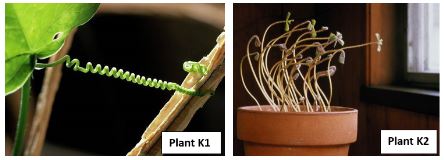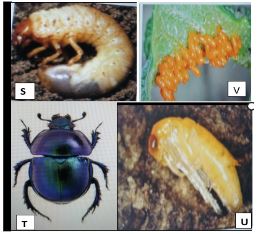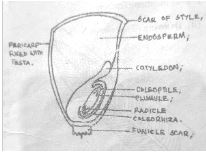Questions
INSTRUCTIONS TO CANDIDATES
- Answer all the questions in the spaces provided.
- You are required to spend the first 15 minutes of the 1 ¾ hours allowed for this paper reading the whole paper carefully before commencing your work.
- You are provided with specimen P and Q. Examine them carefully and answer the questions that follow.
- State three observable differences between P and Q. (3mks)
Specimen P Specimen Q - Identify the parts of the flower from which specimen P and Q developed. (2mks)
P
Q -
- Make a longitudinal section of specimen P. Draw a well-labelled diagram of one half with all its Contents intact. (4mks)
- State the functions of any two structures in (c) (i) above. (2mks)
- Using a mortar and pestle crush specimen Q, add 5ml distilled water to make a solution Q and carry out appropriate tests using the reagents provided. (6mks)
Test Procedure Observation Conclusion
- State three observable differences between P and Q. (3mks)
- Study the photos below.
- Name:-
- The stimulus operating in Plant K1. (1mk)
- The type of response being investigated in Plant K2. (1mk)
- Suggest a control set up for Plant K2 investigation. (1mk)
- Describe the role of auxins in the response exhibited by Plant K1. (4mks)
- What is the biological value of the tropisms evident in: -
- Plant K1 (1mk)
- Plant K2 (1mk)
- Name:-
- Below are photos of of a certain arthropod at different stages of its life cycle.
- Identify the stage of the life cycle represented by organism S. (1mk)
-
- Name the stage that immediately preceed and succeed organism S in the life cycle. (2mks)
Preceeding stage
Succeeding stage. - What name is given to the complete life cycle of the arthropod? (1mk)
- Name the stage that immediately preceed and succeed organism S in the life cycle. (2mks)
- Name the gaseous exchange system of orgaism S. Give a visible featuret that supports your answer. (2mks)
-
- What type of food does organisms S feed on? Give a reason to support your answer. (2mks)
- State the significance of stage U in the life cycle of the beetle. (2mks)
- How is specimen T adapted to locomotion in its habitat ? (2mks)
- State the role of the following in the life cycle of the arthropods. (2mks)
- Juvinile hormone.
- Moulting stimulating hormone.
Marking Scheme
-
-
Specimen P Specimen Q -Has two scars -Has one scar -Has one cotyledon -Has two cotyledons -Has Food stored in endosperm -Stores food in cotyledons. - P- Ovary;
Q- Ovule; -
- D-1mk
L- 1X3= 3mks N/B Mark first 3 labels clockwise. - -Endosperm- Storage of food;
-Embryo (plumule and radicle)- Develops into shoot and roots;
-Testa – Protects inner delicate parts/embryo;
- Coleoptile – Protects plumule from mechanical damage during germination;
- D-1mk
-
Test Procedure Observation Conclusion Starch To 2ml solution Q,
Add 3drps of Iodine solution;Blue black colour ; Starch present; Protein To 2ml solution Q,
Add equal amount of sodium hydroxide.
Add Copper(II) sulphate drop by drop;Colour changes to purple/violet/mauve; Proteins present;
-
-
-
- Touch;
- Positive phototropism;
- Place the potted plant on a revolving klinostat in a similar set up.
- When the tendril comes into contact with the upright firm support; auxins migrate to the opposite side/side away from touch;
This causes faster cell growth/ cell elongation on the side away from the contact/OR causes
Slower growth on the side in contact with the firm support; and the tendril coils round the support; -
- K1- It offers support to the non-woody stem/plant;
K2- The plant shoot grows towards the source of light in order to photosynthesize;
- K1- It offers support to the non-woody stem/plant;
-
-
- S- Larva;
-
- Preceding stage -Larva;
Succeeding stage- Pupa; - Complete metamorphosis;
- Preceding stage -Larva;
- – Tracheal system;
- Presence of spiracles; -
- - Vegetation/ plant material;
- Has biting mouth parts; - It undergoes re-organization of body tissues to form the adult form (ie metamorphosis);
- – Has wings for flight;
Has jointed legs for walking/crawling;
- - Vegetation/ plant material;
-
- - Stimulates shedding of the larval cuticle while retaining the youthful characteristics/ prevents metamorphosis;
- Stimulates shedding of the adult cuticle/moulting in adult;
Join our whatsapp group for latest updates
Tap Here to Download for 50/-
Get on WhatsApp for 50/-
Download Biology Paper 3 Questions and Answers - Baringo North Joint Evaluation Mock Exams 2022.
Tap Here to Download for 50/-
Get on WhatsApp for 50/-
Why download?
- ✔ To read offline at any time.
- ✔ To Print at your convenience
- ✔ Share Easily with Friends / Students



